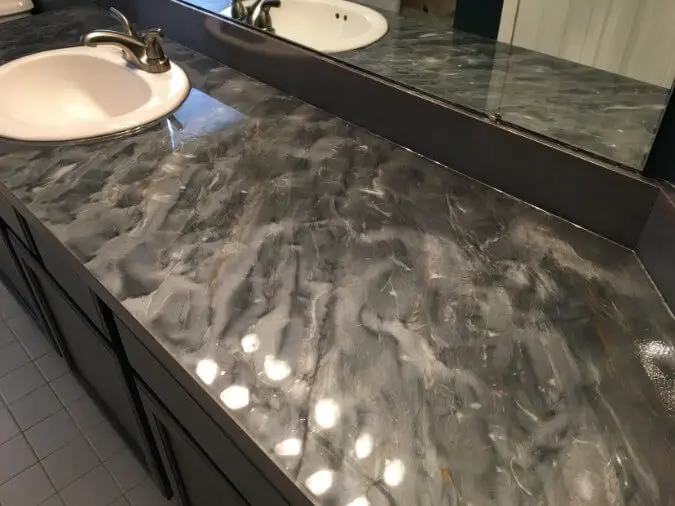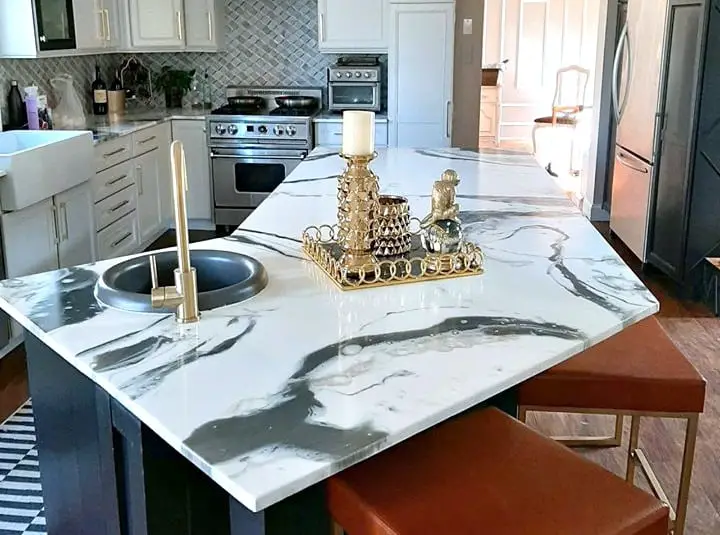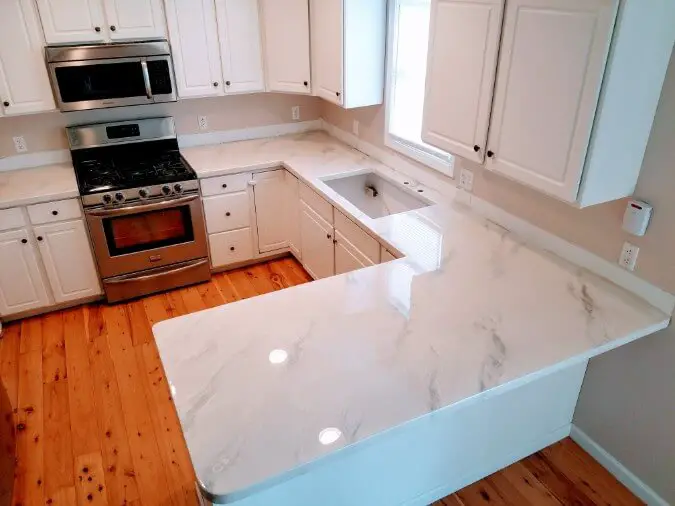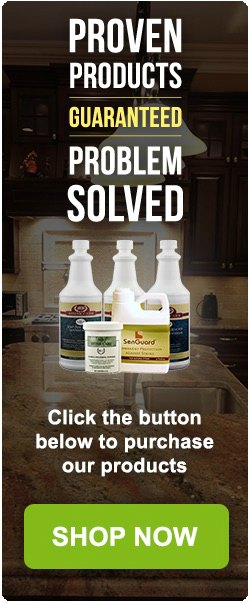The Advantages and Disadvantages of
Epoxy Countertops
Epoxy countertops have become a rising trend among fearless DIYers looking for cheap countertops or creative ways to update their bathroom and kitchen style without breaking the bank.
The results can be absolutely amazing and unique, but the disadvantages of epoxy countertops should be well-considered before jumping in.
I'll detail how they’re made, all the pros and cons, cleaning, installation, and costs to help you decide if you’re up for it.
On This Page...
- What Are Epoxy Countertops?
- How Are Epoxy Countertops Made?
- Pros and Cons of Epoxy Countertops in Your Kitchen
- Epoxy Countertop Design Options
- Epoxy Countertops Cost
- How to Clean Epoxy Countertops
What Are Epoxy Countertops?
Epoxy is a resin coating primarily used as a refinishing product. Applying a coating of this material can help restore or revitalize old, worn, or out-of-style bathroom countertops, kitchen countertops, and floors.
So, you can’t really go out and buy pre-made epoxy countertops or slabs like granite, quartz, marble, or laminate countertops. They must be made in place.
Although, interesting to note… Corian and cultured marble are acrylic countertop materials, and epoxy is considered a solid-surface countertop as well.
It’s a popular choice for refinishing due to the durability of the epoxy resin. It can resist scratches and provide years of use before the surface dulls. It can also tolerate most cleaning materials without losing its luster.
You can apply an epoxy layer over most countertop materials, including:
- Formica
- Laminate
- Ceramic
- Metal
- Wood
- Concrete
It is rarely used on top of marble or granite countertops, but it can be done. Most homeowners do not want to cover their expensive granite or marble countertops which add more value to your home than epoxy or any other type of countertop. Traditional natural stone restoration is the best way to refinish or revive these surfaces.
With some epoxy products or an epoxy counter top kit, you can recreate the look of these surfaces at a fraction of the cost which is a definite advantage.
Epoxy is often used as a sealer for concrete countertops. It adheres better than an acrylic resin.
There are many types of epoxies and brands, but some are much better for countertop projects.
I recommend these epoxy countertop kits, products, and pigments for quality, durability, ease-of-use, and best results:
How Are Epoxy Countertops Made?
DIY epoxy countertops are created by mixing a resin with a hardener. Both substances are sold in liquid form and become solid when mixed.
It hardens quickly, is tricky to work with, and messy which are the main disadvantages of epoxy countertops as I’ll discuss more thoroughly below.
However, once installed, the result is a crystal-clear and glossy finish for your countertops unless you choose a textured epoxy product.
 Epoxy bathroom vanity. Image source: Leggari
Epoxy bathroom vanity. Image source: LeggariDepending on how much epoxy gets used, you may add about one-eighth of an inch of shiny protective coating.
You can purchase epoxy countertop kits or hire a professional to carry out the task.
You can save a lot of money and create some exciting and unique designs upgrading your bathroom or kitchen countertops with epoxy, but be warned, it’s a ton of work with unpredictable results.
Epoxy Resin Application Tips:
The process involves careful preparation, mixing, and application of the epoxy resin across the countertops.
- Thoroughly clean the old countertop surface.
- Protect cabinets and floors with plastic sheeting.
- Start with a thin layer to create a seal.
- Epoxy hardens quickly after mixing the two substances.
- Let epoxy resin harden before adding a second layer.
Any debris that you leave on the surface gets sealed in place. It may then be visible or create an uneven surface.
As epoxy flows like honey, it can quickly run off the edges of the countertop onto the floor or into the sink! It’s common practice to add a piece of wood or barrier around the edge to keep the epoxy mixture from running to the ground.
The epoxy resin and hardener are mixed in a container and then poured onto the countertop. Applying a thin first “seal” layer is called flooding and helps minimize the risk of bubbles.
You typically have about 20 to 30 minutes before the liquid begins to harden. If air bubbles appear, it’s important to try to get them out immediately using a blow dryer or torch causing the bubbles to heat and rise to the surface.
Within a few hours, the epoxy finish should be hard enough to add another layer. After 24 hours of curing, you should have a nice, new epoxy finish on your countertops.
How many coats of epoxy do you need for a countertop?
Typically only one coat of epoxy is needed for a countertop after first applying a base coat. However, two or more coats may be applied if you want a thick epoxy layer over your countertops.
See How Epoxy Countertops Are Applied in This Video...
Pros and Cons of Epoxy Countertops in Your Kitchen
There are several great reasons to consider applying an epoxy finish to your kitchen countertops. But the disadvantages of epoxy countertops should be seriously discussed before moving forward with your project to help avoid any kitchen remodeling mistakes.
Advantages of Epoxy Countertops
- Durable Resin Finish
- High-Gloss Finish
- Unlimited Design Potential
- Seamless
- Heat resistant
- Nontoxic and food safe
- Easy to clean
When epoxy hardens, it creates a solid surface that should last for years. I love epoxy due to its long-lasting shine. Unlike varnishes and other types of coatings, you don’t need to continually reapply the material when it starts to dull.
The durable finish holds up well in comparison to other types of countertop materials and coatings. Cracking or damaging the epoxy surface is something that I rarely see.
If you like a super-shiny and glossy polished finish, then you’ll love epoxy. You can’t get much glossier. It does wear down some in time, but you can maintain that high-gloss look with periodic applications of mineral oil.
Epoxy is likely the most versatile countertop material when it comes to design possibilities. Essentially any color or pattern you can dream of can be created.
Epoxy is the only type of countertop that can offer a genuinely seamless surface for continuous color and pattern.
You can set a hot dish on the surface without instantly ruining your countertop. Keep in mind that if you leave a heated baking dish or a hot coffee carafe on a layer of epoxy, it will eventually damage the surface. Epoxy is heat resistant, but not heatproof.
It's smart to use trivets for hot pots to protect epoxy counters or any type of kitchen countertop from heat damage.
Most epoxy products are considered non-toxic and are food-safe for countertops once the epoxy resin has cured.
The chemicals that you combine to create the hard surface usually contain some volatile organic compounds (VOCs), so proper ventilation is required during application and for a few days after as the VOC’s evaporate.
The epoxy brands that I trust strive to limit the presence of these harmful substances.
You can use almost any cleaning product on it without damaging the epoxy, ensuring that you have a safe place to prepare your foods. The nonporous surface is also resistant to mold and bacteria growth.
Better Life cleaner is very popular and highly recommended. Natural, non-toxic, and effective for cleaning all types of grease and grime.
 Epoxy countertops white and grey | Image source: Leggari
Epoxy countertops white and grey | Image source: LeggariDisadvantages of Epoxy Countertops
- Challenging and Messy to Apply
- Time-Consuming to Apply
- No Second Chances
- Inconsistent Quality
- Prone to Staining
One of the main disadvantages of epoxy counter tops is the troublesome task of applying the epoxy.
Sure, you’ll see photos online of some stunning colors and designs made with epoxy countertop kits, But it ain’t easy even for a fearless DIYer.
Adding an epoxy finish to an existing countertop is messy and complicated, primarily if you’ve never worked with the material.
It’s a good idea to practice first before tackling your first major project that you really don’t want to mess up.
Epoxy requires even application to avoid creating a lumpy surface and air bubbles. If you’re not careful, you may end up needing to remove the epoxy and start over, wasting your time and material.
Most epoxies are “self-leveling” which means they flow across the surface and over the edge. That’s how the epoxy becomes level. So, you’ll get lots of dripping off the countertop edges.
Besides being problematic to apply, an epoxy application is also time consuming and labor-intensive. You need to take the time to thoroughly prep the surface.
You may need to sand the countertops, remove surface stains, etc.
Also, you need to basically cover the entire interior of your house with plastic sheeting.
I’m exaggerating a bit, but seriously, you do need to mask off with tape and plastic sheeting everything around the countertops (cabinets, floors, sink, cooktop, walls, backsplash), and even add boards around the countertop edges to catch the drips as the epoxy flows over the edges.
Get the pre-taped plastic sheeting. Makes it waaaaaay easier to apply and cover cabinets, walls, etc. Use heavier tarps for the floor to avoid tearing or tripping over the plastic.
And be careful with the application to avoid defects or air bubbles. The curing time may also take up to 24 hours.
For these reasons, making DIY epoxy countertops isn’t a quick or easy process.
Creating the colors and pattern of an epoxy countertop is done live on the fly. You’re winging it and hoping you like the results. Now that is both an advantage and a disadvantage of epoxy countertops.
On the one hand, you are creating an individual and unique piece of art. On the other hand, maybe you get a little too crafty, and the result looks like a kid just learning to color. Still art, but likely not as cool as you had envisioned.
You can redo it, but that’s a lot more time, effort, money, and even more mess.
Keep it simple with colors and designs if it’s your first time.
Another issue is the inconsistent quality of the materials. Not all epoxy counter top kits and products offer the same results.
I’ve come across many inferior products that are either more brittle or less heat resistant compared to some of the recommended brands.
You can detect the quality of the epoxy as soon as you start pouring. The less expensive epoxies are runny. Quality epoxies are thick. With a less expensive epoxy, you get a thinner layer that may not hold up as well compared to the better products.
Before using an epoxy finish, you should learn more about it. Read reviews, etc.
While epoxy is durable, it does stain easily if spills are not adequately cleaned. Always clean food or drink spills immediately to reduce the risk of permanent stains.
Our Recommended Epoxy Counter Top Kits & Products:
This Marine Epoxy and this Crystal Clear Epoxy are what I recommend. These are your best bets for ease-of-application and consistently great results.
Stone Coat Countertops Epoxy Kit is another solid choice. It comes with all you need to create marble-look countertops.
You'll need to calculate how many gallons you'll need based on the square footage of your project and how thick you want the epoxy coat to be.
Epoxy color pigments can be added to create unique countertop patterns and colors that suit your style.
Epoxy Countertop Design Options
Epoxy countertops do excel at providing some exciting design options. Really, any design, pattern, or color you can imagine is possible.
 Kitchen remodel with white epoxy countertops. Image source: Leggari
Kitchen remodel with white epoxy countertops. Image source: LeggariThis is done by creating your design on the existing countertop material that you’ll be covering with epoxy or created within the epoxy resin itself.
Objects can be embedded within or under the resin. Some homeowners use the epoxy resin to create countertop mosaics out of bottle caps, coins, or pieces of tile.
In addition, backlighting can be used to make your countertop glow.
Of course, I also like the look of a clear epoxy coating over a nice hardwood countertop. In fact, covering wood countertops is one of the most popular uses of epoxy resin.
You can also add epoxy to almost any surface, helping to add shine to a worn laminate or Formica countertops. Epoxy coatings on stone countertops may help prevent etching of limestone or marble, although other factors should be considered first.
Some manufacturers create specialty finishes that mimic marble or granite countertops, such as Stone Coat and Leggari.
Or you can create natural stone patterns yourself.
Suffice it to say that you can turn virtually unlimited epoxy countertop ideas into reality.
Creating Your Own Epoxy Colors
The epoxy is a transparent substance and can be combined with a clear hardener. You can also choose colors to recreate a stone pattern or other design effects.
Various epoxy manufacturers allow customers to create their own distinct epoxy finish by choosing different resin tints or acrylic paints. This often starts with the selection of a base color.
The base color and an accent color can be combined to help recreate the veins and patterns found in natural stone.
Common base colors include white, silver, gray, green, red, and copper. You can then add a metallic powder to accent this base color.
Some manufacturers also offer metallic glitters that can add flecks of color in your epoxy finish. These glitters work best when they complement the accent color.
If you want the look of granite or marble, choosing the color combination is just half the battle. Special techniques need to be used to add the swirls, veins, and patterns found in real stone.
I recommend that you watch video tutorials on how to use these techniques before attempting them yourself. You could also try pouring the epoxy on a small sample board before trying it on your countertops.
Epoxy Countertops Cost
Cost is a top reason to consider using epoxy. Compared to most types of countertops, refinishing a surface with epoxy is incredibly cost-effective.
- Expect to pay about $3 to $8 per square foot for epoxy countertops.
The total cost depends on whether you decide to hire a professional or DIY and several factors, including:
- The quality of the epoxy material
- The surface area of the countertops
- The thickness of the epoxy layers
The least expensive products tend to cost about $3 per square foot. When using some of the better options, you may spend up to $7 or $8 per square foot.
So, epoxy countertop costs vs. granite or other kitchen countertop materials are far less and a perfect option if you’re on a budget and want cheap countertops.
Although, laminate countertops are a top budget option as well.
If you want a contractor to handle the work, you also need to factor in the cost of labor and then costs go up considerably.
You may get charged $35 to $85 per hour of work, which may equal about one hour per square foot.
When you combine labor and material, you may spend between $25 to $100 per square foot to hire a professional to coat your kitchen countertops with epoxy.
However, professionals can create some absolutely stunning epoxy countertop designs.
Doing it yourself can save you considerable money if you apply the epoxy correctly. If you end up needing to remove a layer due to air bubbles or improper preparation, the costs go up.
While the square footage of your countertops is the most significant factor in determining the cost, you also need to consider the thickness of the epoxy layer. If you plan to apply an extra thick layer, you may need to spend a little more on materials.
How To Clean Epoxy Countertops
Epoxy countertops are incredibly easy to keep clean. You can use a wide variety of cleaning products and methods without damaging the surface, but there are a few details to keep in mind.
Avoid using abrasive cleaning products, as they may scratch or dull the surface. In some cases, the abrasive cleaner may leave swirl marks on the countertop.
You should also skip the scouring pads, waxes, or polishes.
Better Life cleaner is excellent for cleaning epoxy countertops.
To maintain the brilliant shine, I also recommend that you perform a simple maintenance task.
Apply a small amount of quality mineral oil to the surface once of week or month. The oil helps keep the surface from dulling, unless you use too much, which can produce the opposite effect.
Adding too much oil can create a cloudy appearance. If you add too much, wipe it away with a cloth.
As mentioned, the epoxy material can stain easily. However, this also depends on the quality of the product. With some of the top brands, you don’t have to worry about stains as much.
To avoid stains, clean up your spills immediately with a paper towel or washcloth. You can also make a baking soda paste to help prevent stains on your epoxy countertops.
When you discover the stain too late, you may still have a chance to remove it before it causes permanent damage.
Combine one part water to four parts baking soda. Apply this paste directly to the stain and allow it to sit for five minutes. Wipe the mixture away with a cloth and with luck, the stain should be gone.
If the stain remains, there is one more solution. You can use a paint thinner or acetone to get rid of stains from wine, coffee, or berries.
Dip a cloth in the acetone and gently rub the stain using a circular motion. You can add a little more pressure if the stain doesn’t immediately come out.
Never use bleach to attempt stain removal. The bleach can create its own stain on your countertops.
Conclusion
You can make some really cool designs with epoxy countertops, and they are the glossiest for those that like shiny things. That is perhaps the most significant advantage along with the super-low cost which makes epoxy a great discount countertop option.
It’s also relatively durable and easy to clean and maintain.
However, the disadvantages of epoxy countertops can be intimidating. Installation is labor-intensive and messy. Epoxy is just a difficult material to work with, so preparation is key and experience is very helpful.
But DIYers do it everyday, so if you’re up for the challenge, you can create not only durable and functional bathroom or kitchen countertops, but an original work of art you can enjoy every day.
Related Content:
Kitchen Countertop Comparison Guides
21 Kitchen Remodeling Mistakes To Avoid



